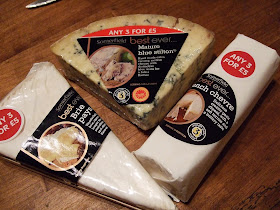
Yesterday I went down to St Nicholas market to be interviewed about ‘Frugal’ by the Bristol Evening Post, an opportunity to do a bit of browsing at my favourite new food shop and café
Taste@St Nicks. They were selling Penclawdd cockles from the Gower peninsula, a delicacy you don’t often come across. I remember having them deep-fried when we were there earlier this year and they were fantastic. And at £1.80 a 100g (all you need for two) they’re a thrifty buy.
This time I thought I’d use them in a simple spaghetti sauce, a bit like a Welsh
spaghetti alla vongole with bacon. And Thai fish sauce which sounds weird but just accentuates the fishiness of anything you add it to. Here’s how to do it:
Serves 2
2 tbsp olive oil + extra for drizzling
3 rashers of streaky bacon, rinded and finely chopped
1 medium onion, peeled and finely chopped
1 small clove of garlic, peeled and crushed
1/2 a small glass of dry white wine or water (about 75ml)
1/2 tsp of Thai fish sauce (slightly more if you use water)
100g cockles (if you can’t get fresh ones you could use a jar, though drain and rinse them before you add them to the sauce)
200g spaghetti
A small handful of parsley, finely chopped
Ground black pepper
Heat the oil in a frying pan over a moderate heat and add the bacon. Cook for a minute until the fat starts to run then add the onion, stir, turn the heat down and cook for about 10 minutes until the onion is soft and beginning to brown. Stir in the crushed garlic, cook for a minute then turn the heat up a bit and add the white wine and fish sauce. Bubble up for a minute then take the pan off the heat, tip in the cockles and set aside. Cook the spaghetti in boiling water for the time recommended on the pack. Spoon off 2-3 tbsp of the cooking water into the bacon and cockles then drain the spaghetti. Return to the pan, heat through the sauce, tip it over the spaghetti along with most of the parsley and toss together. Divide the spaghetti between two warm shallow bowls, drizzle over a little olive oil, add a few grinds of pepper and sprinkle with a little more parsley.
 If you like good bread - which we do - you normally have to pay a fair bit for it. This country loaf (above) is normally priced at £2.50 in our local deli but my husband, who is determined to prove he's a more frugal shopper than I am, picked it up yesterday for just £1.25 because it had been left over from the previous day
If you like good bread - which we do - you normally have to pay a fair bit for it. This country loaf (above) is normally priced at £2.50 in our local deli but my husband, who is determined to prove he's a more frugal shopper than I am, picked it up yesterday for just £1.25 because it had been left over from the previous day 













